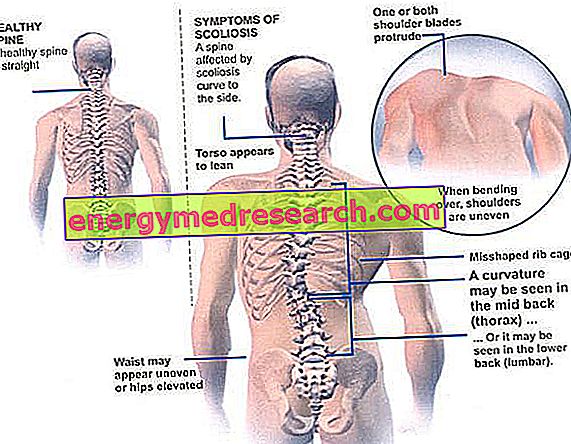Generality
The abdominoplasty is the operation of aesthetic surgery, aimed at removing the adipose tissue and excess skin; serves to improve the appearance of the abdomen, but is not a treatment for weight control.

There are three main types of abdominoplasty: complete abdominoplasty, partial abdominoplasty (or mini-abdominoplasty) and extended abdominoplasty.
Abdominoplasty is a major surgery, so it presents risks and complications.
The complete recovery from an abdominoplasty mainly depends on the modalities of intervention.
In general, the results satisfy patients.
What is abdominoplasty?
The abdominoplasty is the cosmetic surgery intervention that serves to remove the accumulations of abdominal adipose tissue, associated with an excess of skin and a relaxation of the abdominal muscular wall.
The goal of abdominoplasty is to improve the appearance of the abdomen, eliminating part of the so-called "imperfections" and trying to make the muscles located here stand out more.
WHAT IS NOT?
Contrary to what some people may think, abdominoplasty is not a surgical treatment for weight control.
In other words, if those who undergo an abdominoplasty do not adopt a healthy lifestyle and do not feed themselves in a balanced way, they recover the abdominal aspect they had before the operation.
Therefore, in order for the abdominoplasty to provide permanent results, it is essential that the people involved control the caloric intake and keep fit with healthy exercise.
uses
The ideal candidates for abdominoplasty surgery are:
- Women who have been the protagonists of numerous pregnancies and who, because of this, have an abdomen with accumulations of adipose tissue, extremely relaxed and with excesses of skin difficult to eliminate with physical exercise. Generally, women with these problems also have a condition known as abdominal diastasis . Abdominal diastasis is the pathological separation of the right abdominal muscle from the left abdominal rectus muscle.
The abdominoplasty is an operation also indicated for the resolution of serious abdominal diastase episodes;
- The men and women who present the after-effects of a drastic weight-loss diet, implemented to treat severe obesity. The after-effects consist of abdominal fat deposits that are difficult to remove, abdominal skin excesses, unsightly abdominal folds, etc.
FOR THOSE WHO ARE NOT APPROPRIATE?
Abdominoplasty is not an intervention to treat obesity. The treatments for the latter are others, starting from: the constant practice of physical activity and the control of nutrition (appropriate diet).
Preparation
Abdominoplasty is a major surgery, therefore it requires special preparation.
First of all, the future patient must:
- Stop smoking if you are a smoker. Cigarette smoking favors the onset of infections at surgical wound level, resulting from the future abdominoplasty. Furthermore, it alters the blood supply to the skin and this slows down the healing process of the aforementioned surgical wounds.
Generally, doctors recommend quitting at least two weeks before the operation and, if the patient wants to start again, to resume only after two weeks have passed since the operation;
- Lose weight and achieve body weight considered ideal by the doctor who will perform the surgery;
- Stop taking the contraceptive pill. Clearly, this pre-operative indication applies if the patient is a woman and uses the aforementioned contraceptive method. The contraceptive pill promotes thrombosis episodes; interrupting their use reduces the risk of thrombosis;
- Stop taking any antiplatelet drugs (aspirin) and anticoagulants (warfarin). This pre-operative indication is explained by the fact that the aforementioned drugs dilute the blood and therefore represent a factor favoring bleeding.
From the injuries of the abdominoplasty there is a loss of blood, which, if the aforementioned drugs are taken, can be conspicuous and dangerous for the patient's health;
- Warn the medical personnel of any allergies to all those drugs (painkillers, sedatives, anesthetics, etc.), which could be used during abdominoplasty surgery.
Abdominoplasty is an operation that requires, shortly before its execution, the practice of general anesthesia .
In order that general anesthesia does not involve complications, it is essential that the patient, on the day of the operation, presents himself at full fast from at least the previous evening. By complete fasting, abstention from foods and drinks other than water is meant; the latter is allowed up to a few hours after the procedure.
What are the main implications of general anesthesia?
Task of an anesthesiologist, the practice of general anesthesia involves:
- Sleeping of the patient for the duration of the procedure;
- Continuous monitoring of the patient's vital parameters (heart rate, blood pressure, body temperature, oxygen level in the blood, etc.), through appropriate instrumentation.
Generally, the anesthetic for falling asleep takes effect within 10-15 minutes; its administration lasts for the whole duration of the intervention. Waking up occurs at the end of the procedure and when the anesthesiologist interrupts the injection of the anesthetic.
PRE-OPERATOR EXAMS
Normally about a week before the operation, the patient must present himself at the hospital, where the operation will be held, to undergo a series of clinical tests .
These clinical examination tests - also known as pre-operative examinations - serve the operating surgeon to make sure that there are no contraindications to the operation. Among the classic pre-operative examinations, we include the blood test, the urine test, the electrocardiogram and the blood pressure measurement.
PRE-OPERATIVE CONSULTATION
The preparatory phase for an operation such as abdominoplasty also includes a consultative meeting between the operating physician and the future patient, during which the first exposes the intervention method (from how the procedure is performed to the possible complications) and the second has the opportunity to remove any doubt about procedural aspects that are still unclear.
Procedure
There are various types of abdominoplasty. Some types are ideal for eliminating large quantities of fat and excess skin; other types, on the other hand, are suitable for the removal of fat accumulations and moderate / circumscribed excesses of skin.
The main types of abdominoplasty are:
- Complete or standard abdominoplasty ;
- Partial abdominoplasty or mini-abdominoplasty ;
- Extended abdominoplasty .
WHAT DOES THE CHOICE OF THE TYPE OF ABDOMINOPLASTIC DEPEND ON?
The choice of which type of abdominoplasty to practice is up to the operating surgeon and depends, quite intuitively, on the quantity and location of abdominal fat and excess skin in this area.

COMPLETE OR STANDARD ABDOMINOPLASTY
Complete abdominoplasty is suitable for the removal of large quantities of adipose tissue and skin; in addition, it guarantees the ability to reshape the abdominal muscle wall more easily and with good results.
From a strictly technical-operational point of view, the complete abdominoplasty includes:
- The incision of the abdomen from side to side and just above the pubic area. As is easy to imagine, it is an incision of important dimensions;
- A second incision around the navel, in such a way as to "free" the latter from the surrounding skin;
- The detachment of the skin and adipose tissue from the abdominal muscle wall;
- Removal of the skin and fatty tissue considered too much. In this phase of the operation, the surgeon also provides for the repair of the abdominal muscular wall, if the latter has anomalies or is, in some way, altered;
- The relocation of the navel and the suturing of the latter to the parts of skin resulting after the previous passage;
- The suture of the first major surgical incision;
- Application of a protective bandage, which covers all surgical wound.
A complete abdominoplasty is an operation that can last up to 5 hours; on average, it lasts 3.
PARTIAL OR MINI-ADDOMINOPLASTIC ABDOMINOPLASTY
Partial abdominoplasty is suitable for those who need to remove small amounts of fat and / or excess skin.
From a strictly technical-operational point of view, partial abdominoplasty involves:
- Performing a curved incision on the abdomen, precisely a little higher than the pubic area;
- The detachment of the skin and adipose tissue from the abdominal muscular wall, located just below the navel;
- Removal of the skin and adipose tissue detached from the abdominal muscle wall located just below the navel. In this phase of the procedure, the surgeon also provides for the repair of the abdominal muscular wall, if the latter has anomalies or is, in some way, altered;
- The incision suture;
- Application of a protective bandage, which covers all surgical wound.
As readers will surely have noticed, there is no incision of the navel, which remains in its original position for the duration of the intervention.
Partial abdominoplasty is an operation that generally lasts a couple of hours at most.
EXTENDED ABDOMINOPLASTY
Extended abdominoplasty is suitable for removing large amounts of fatty tissue and skin on the abdomen, hips and part of the back. In fact, it corresponds to a complete abdominoplasty, with the additional removal of fatty tissue from the hips and the lumbar area closest to the hips.
From a strictly technical-operational point of view, partial abdominoplasty involves:
- Performing a large incision, which includes the entire abdominal pubic area, the two sides and the lumbar region immediately after the sides of the body;
- A second incision around the navel, in such a way as to "free" the latter from the surrounding skin;
- Detachment of the skin and fatty tissue from the underlying muscle walls. This part of the procedure obviously concerns all the anatomical areas from which the doctor wants to remove the fat and excess skin;
- Removal of the skin and fatty tissue considered too much. In this phase of the intervention, the surgeon also provides for the repair of the abdominal muscular wall, if the latter has anomalies or is, in some way, altered;
- The relocation of the navel and the suturing of the latter to the parts of skin resulting after the previous passage;
- The suture of the first major surgical incision;
- Application of a protective bandage, which covers all surgical wound.
Extended abdominoplasty is an operation that can last from 3 to 5 hours.
Post-operative phase
At the end of abdominoplasty and waking up from general anesthesia, hospitalization is always expected.
The duration of hospitalization varies according to the type of abdominoplasty: for example, for extended abdominoplasty operations - which are quite invasive - hospitalization can last up to 4 days; while, for partial abdominoplasty operations - which are less invasive than the previous ones - the hospitalization has a maximum duration of a couple of days.
During the entire hospitalization period, medical personnel periodically monitor the patient's vital signs; moreover, it provides for the continuous drainage of blood and other fluids from the surgical wound, through a special tube. Removal of this tube occurs shortly before discharge.
For the resignation and above all for the return home, it is good that the patient asks for the support of a relative or a close friend.
POST-OPERATIVE SENSATION
It is quite normal that after the abdominoplasty, the patient feels:
- Pain at the level of the operated area. In general, this feeling is resolved within a few days. If it persists or should be particularly acute, it is advisable to use painkillers (eg: ibuprofen or paracetamol);
- Confusion and stunning. They are effects due to general anesthesia. They are resolved within 24 hours maximum;
- Feeling tired. Abdominoplasty is an intervention that removes many energies from patients, who need a few days to recover in an acceptable manner.
POST-OPERATION RECOMMENDATIONS
The most important medical recommendations regarding the post-operative phase include:
- Observance of a rest period from any tiring activity (lifting weights, strenuous exercise, etc.). Doctors consider it a duty to follow this recommendation for at least 6 weeks;
- The cleaning of the wound and of the protective bandage, which the operating doctor applied at the end of the operation;
- Do not smoke for at least a couple of weeks. The effects of smoking have already been widely discussed previously.
Frequently asked questions about resuming daily activities: |
Q: When is it advisable to resume work? R: In case of not particularly tiring works, the resumption of the activity can take place after 4 weeks; in case of very heavy work, it is better to wait at least a couple of weeks more. |
Q: When is it possible to resume the practice of physical activities of modest intensity, without the risk of complications? R: After 10-20 days. |
REMOVAL OF SUTURE POINTS
Sutures applied during the final stage of abdominoplasty may be resorbable or non-resorbable.
If the sutures are resorbable, their removal occurs spontaneously, without the patient having to go to the surgeon operating in the days following discharge. If, on the other hand, the sutures are non-absorbable, their removal requires the intervention of the attending surgeon; in general, it is the latter who establishes an appropriate date for the removal of the so-called "stitches".
Recovery
The duration of recovery from an abdominoplasty operation depends on the type of procedure, to which the plastic surgeon has resorted. For complex operations, such as those of extended abdominoplasty, the recovery phase can take from 3 to 6 months ; for simpler operations, such as those of partial abdominoplasty, however, it can take 6 weeks or so .
It must not be forgotten that the age of the patient, the attention that he pays to pre- and post-operative recommendations, etc., also affect his recovery times.
Despite the recent advances in plastic surgery, the surgical incision, practiced during abdominoplasty, still leaves a scar.
Risks and complications
Abdominoplasty is a major surgery, therefore, like any operation of this kind, it presents certain risks and can lead to complications, sometimes even very serious.
ADVERSE EFFECTS
For adverse effects, doctors mean minor issues.
In the case of abdominoplasty, the main adverse effects are:
- Sharp and protracted pain for longer than normal;
- The appearance of large hematomas at the level of the operated area;
- Swelling at the intervention area level;
- Presence of a very obvious scar.
COMPLICATIONS
For complications, doctors mean problems of a certain clinical relevance.
The complications of abdominoplasty include:
- Episodes of infection;
- Episodes of subcutaneous bleeding;
- Seroma episodes;
- Permanent sense of numbness
- Obvious redness of the scar, resulting from the surgical incision;
- Formation of a blood clot in the pulmonary arteries and one of their branches (pulmonary embolism);
- Slow healing of the surgical wound
Contraindications
The abdominoplasty has some contraindications.
In fact, it is unsuitable for:
- Subjects with a heart disease (so-called cardiopaths);
- People with diabetes;
- People with severe obesity;
- Women of childbearing age, who want to have a child. If all the conditions of intervention exist, the subjects in question can undergo an abdominoplasty once the pregnancy or the desired pregnancies are completed.
Related and alternative interventions
Sometimes, women who need a tummy tuck are also candidates for alternative interventions: liposuction, body remodeling (or body lifting ), reductive mastoplasty, breast lift and / or hysterectomy.
Of the aforementioned surgical procedures, liposuction deserves special attention. The latter can be not only an intervention related to abdominoplasty, but also an alternative; much depends on the elasticity of the patient's skin.
Liposuction is the surgical procedure of elimination, by aspiration, of fat deposits resistant to the slimming action of a diet or exercise.
Results
Abdominoplasty patients are generally satisfied with the results obtained thanks to the operation. It is quite rare that some individuals are not happy with their final appearance or find it difficult to recognize themselves (since, in some cases, the physical change is really profound).
To maintain the results of abdominoplasty, it is essential to adopt a balanced diet to practice physical activity.



